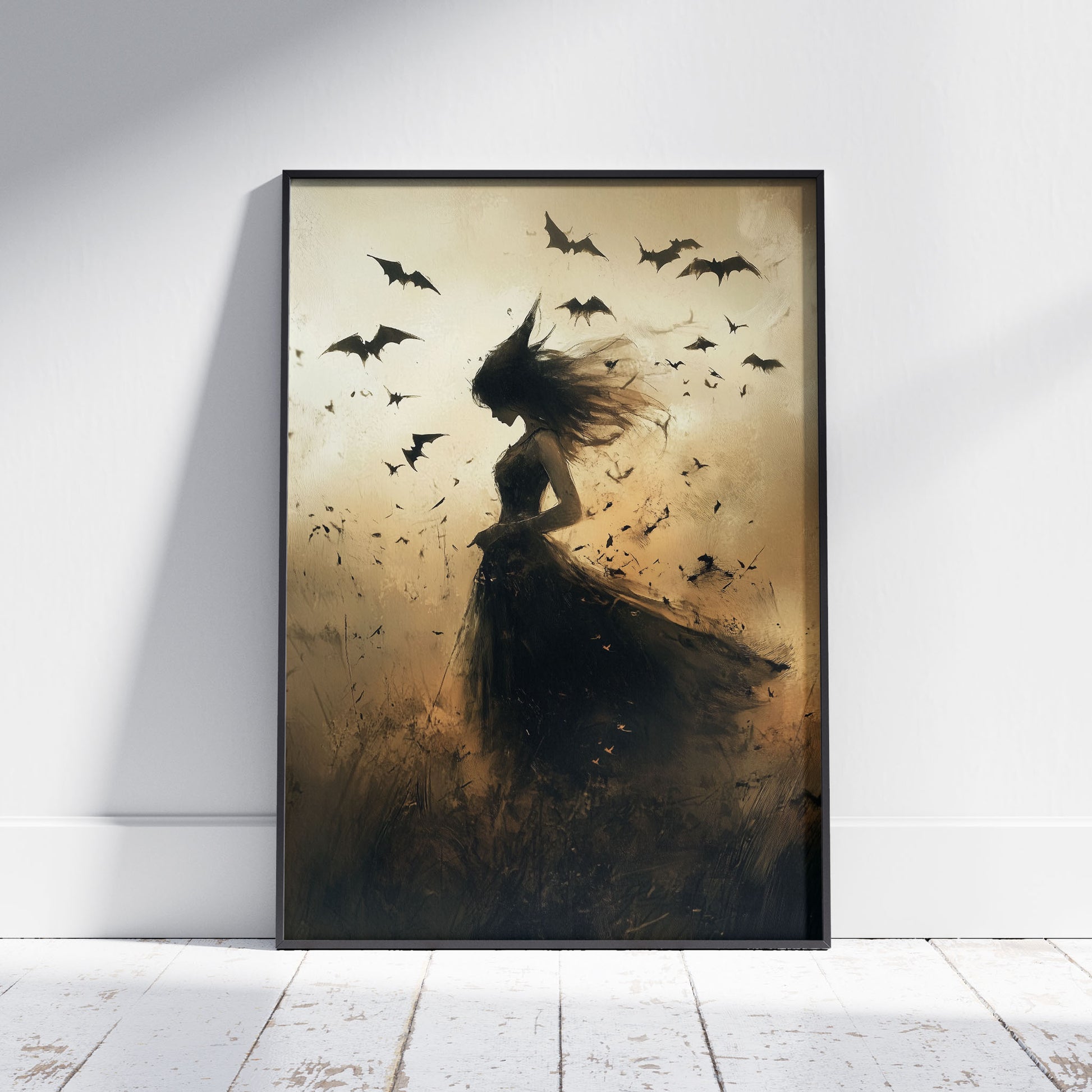
The Enchanting Power of the Shadow Witch: A Deep Dive into Halloween's Most Haunting Visual
ChristianShare
Whispers in the Fog: A Witch, a Storm, and the Spirit of Halloween
Halloween has always been a season of aesthetic extremes - a celebration of the eerie, mysterious, and magical. The artwork we’re analyzing today encapsulates all of that in a single, haunting frame. The image shows a silhouette of a young witch, her dress blending into an abstract fog of shadows, her hair lifted by a ghostly wind, and bats swirling around her like dark confetti. Ethereal and spine-chilling, this visual masterpiece calls to mind stories of haunted meadows and spells whispered on the wind. It isn’t just a seasonal visual - it’s a story in motion.
What makes this witch different from cartoonish renditions is her elegance, composure, and the way the artist marries chaos with beauty. This is an exploration of mystery, femininity, and nature’s darker whims. Let’s break down what makes this image so powerful, piece by piece.
Balance in the Shadows: How Composition Breathes Life into the Witch
The composition of this piece follows a vertical symmetry that pulls the eye upward. The witch is centered, her body in side profile, giving the viewer both intimacy and distance. Her form is elongated, giving a sense of grace, while her flowing dress forms a dramatic downward triangle - anchoring the piece and lending weight to the lower half.
The bats swirl counterclockwise, creating motion that draws the viewer’s gaze in spirals around the central figure. This vortex-like arrangement suggests both chaos and orbit - as if these dark creatures are pulled by her gravity. The placement of elements ensures balance: the bat swarm on the upper left is visually countered by the volume of her dress and its dynamic movement on the bottom right.
The color palette uses limited, muted sepia tones, ensuring that the silhouette stands out starkly. The simplicity of color lets form and motion dominate. Negative space plays a large role, creating breathing room around the central figure so the drama doesn’t overwhelm. Overall, it’s a masterclass in composition, using balance, symmetry, and motion to evoke mystery and elegance.
Brushstrokes of the Beyond: Texture, Light, and Gothic Flourishes
The stylistic execution lies somewhere between digital illustration and traditional painting, borrowing the fluidity of brush strokes and the starkness of ink. The figure of the witch is rendered with deliberate blur and scratchy texture, almost as if she is dissolving into the atmosphere. This painterly blur gives a sense of movement, fragility, and mystique.
Light is handled with subtlety: the background glows in a pale, misty gold, giving an almost spiritual quality to the negative space. It’s not a sunny light, but more like a candlelit fog - warm but dim, haunted but inviting. This interplay of light against the dark figure enhances the supernatural feel.
The bats are not hyper-detailed, instead painted in swift strokes, emphasizing their shape and motion rather than anatomical accuracy. This abstraction gives them a shadowy presence, making them seem like thoughts or spirits rather than actual animals.
The textures in the witch’s dress are particularly rich - dark, almost like smeared charcoal or oil paint, full of folds and crumbling edges. The gown seems to disintegrate into the lower frame, blurring the boundary between the human and the natural or ethereal. There’s intentional roughness, a refusal to be clean or digital - and this, in turn, gives the piece its organic, gothic quality.
The style balances fantasy with emotion, leaning into the aesthetics of Gothic Romanticism - dark beauty, isolation, and a reverence for the wild, untamed aspects of the world and the soul.
The Witch and the Wind: A Tale Told in Shadows and Flight
This image tells a story far deeper than a seasonal theme. The young witch can be seen as an archetype - the empowered feminine, connected deeply with nature, the moon, and hidden knowledge. She doesn’t appear wicked or joyful - she’s pensive, poised, perhaps even sorrowful. This ambiguity makes her emotionally compelling.
The bats represent transformation and the supernatural. In folklore, bats are creatures of the night, guardians of secrets, and symbols of rebirth and intuition. The fact that they surround her, yet do not alarm her, shows a symbiotic connection - she is not running from the darkness, she commands it.
Her hair, blown dramatically by unseen forces, might signify a connection to unseen realms - spirits, winds, or otherworldly powers. Her dress blending with the wind and ground implies she’s not merely standing in the scene; she is of it. There’s no separation between the witch and the environment - she is the wilderness, the haunting mist, the night embodied.
This piece can also be seen as a reflection on solitude. The figure is alone, yet not lonely. She exists with nature as her companion. It paints a version of the witch that isn’t the antagonist of fairy tales but rather a guardian - a solitary, misunderstood figure of wisdom and power.
It’s this blend of strength and sorrow, mystery and elegance, that elevates the image from a Halloween visual to a piece of poetic visual storytelling.
Mist and Myth: Crafting the Haunted Realm Around Her
The background is deceptively simple - a faded blend of beige, sand, and misty gold - but this simplicity is deliberate. It lets the other elements stand out in sharp contrast. The texture of the background resembles brushed canvas or cracked parchment, giving the sense of age and memory, like a faded spellbook or old oil painting.
The absence of clear landmarks or scenery helps maintain the mystique. We don’t know if this is a desert, a field, or a dream. The air feels thick and heavy, as if time is suspended. The bats occupy this middle ground between the subject and the background, flying through space and shadow alike, creating a 3D depth within the fog.
This atmospheric minimalism keeps the viewer’s imagination active. The setting could be a dream world, a post-apocalyptic wasteland, or the aftermath of a magical ritual. It is the perfect setting for a modern myth - suggestive, not prescriptive.
Born of Night: The Witch as the Heart of the Image
The witch’s silhouette is the visual anchor. Her shape is elegant yet slightly off-balance, leaning into the motion of her surroundings. She’s caught in a moment of introspection, neither casting a spell nor flying - just being, caught in the poetry of the moment.
Her facial features are hidden in shadow, leaving her identity ambiguous. This lets viewers project themselves or their own narrative onto her. Her long hair is a character of its own, lifting dramatically to the right, mimicking the flight of the bats and echoing their chaos.
The tattered hem of her gown and the barely-visible linework around her hands ground her as a being of texture and emotion. She is not polished, not glossy. She is raw. Her darkness contrasts beautifully with the glowing mist behind her, creating visual tension and depth.
The foreground vegetation is abstract - thin scratches and painterly swipes - suggesting wild, unkempt land. Nothing here is manicured. It’s a perfect parallel to the witch herself - wild, natural, unbound.
Beauty in the Bleak: The Witch, the Night, and the Viewer’s Soul
Emotionally, the piece resonates with themes of isolation, power, and beauty born of sorrow. It celebrates the gothic without caricature, painting the witch as an emblem of strength and grace within darkness. There's a sense of yearning and introspection - a quiet storm.
This image doesn’t scream Halloween - it whispers it, beckoning the viewer into a poetic, haunted world where beauty and danger dance. It reminds us that Halloween isn’t just about fright - it’s about myth, mood, and the mystery of night.






















